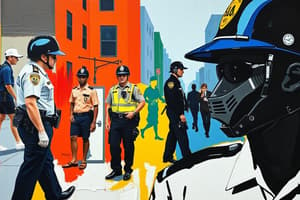Podcast
Questions and Answers
What is the primary focus of community policing?
What is the primary focus of community policing?
- Maintaining public order through surveillance
- Investigating and apprehending offenders
- Strict enforcement of laws with little discretion
- Building relationships with community members (correct)
Which step occurs first in the trial process?
Which step occurs first in the trial process?
- Presentation of Evidence
- Arraignment (correct)
- Jury Selection
- Closing Arguments
What does zero-tolerance policing emphasize?
What does zero-tolerance policing emphasize?
- Community engagement
- Restorative justice practices
- Strict enforcement of laws (correct)
- Addressing underlying issues of crime
Which of the following roles does a prosecutor serve in the trial process?
Which of the following roles does a prosecutor serve in the trial process?
What is the primary objective of corrections in the criminal justice system?
What is the primary objective of corrections in the criminal justice system?
Which theory of justice focuses on punishment as a direct response to crime?
Which theory of justice focuses on punishment as a direct response to crime?
What challenges does overcrowding in prisons primarily result from?
What challenges does overcrowding in prisons primarily result from?
In the criminal justice process, what standard must be met for a conviction?
In the criminal justice process, what standard must be met for a conviction?
What is currently a significant trend in criminal justice reform?
What is currently a significant trend in criminal justice reform?
Which type of policing focuses primarily on building relationships within the community?
Which type of policing focuses primarily on building relationships within the community?
What role do prosecutors play in the court system?
What role do prosecutors play in the court system?
Which of the following is NOT considered a type of correction?
Which of the following is NOT considered a type of correction?
What does the term 'due process' refer to in the judicial system?
What does the term 'due process' refer to in the judicial system?
What is the focus of problem-oriented policing?
What is the focus of problem-oriented policing?
What characterizes zero-tolerance policing?
What characterizes zero-tolerance policing?
How do appellate courts function in the judicial process?
How do appellate courts function in the judicial process?
Which type of crime is generally punishable by fines or short-term jail sentences?
Which type of crime is generally punishable by fines or short-term jail sentences?
What is a significant challenge highlighted in the criminal justice system relating to public perception?
What is a significant challenge highlighted in the criminal justice system relating to public perception?
Which factor is considered in making sentencing decisions within the criminal justice process?
Which factor is considered in making sentencing decisions within the criminal justice process?
What does due process ensure within the legal system?
What does due process ensure within the legal system?
Flashcards are hidden until you start studying
Study Notes
Policing
- Policing serves to maintain public order, enforce laws, and prevent crime.
- Key functions include crime prevention, investigation of offenders, and ensuring community safety.
- Types of policing include:
- Community Policing: Builds relationships with community members to collaboratively address crime.
- Problem-oriented Policing: Identifies and tackles the root causes of crime.
- Zero-tolerance Policing: Enforces laws strictly, often with less discretion for officers.
- Challenges faced in policing:
- Racial profiling and discrimination erodes public trust in law enforcement.
- Concerns regarding the use of force demand accountability and adherence to ethical standards.
- Resource allocation and insufficient funding hinder effective policing efforts.
Courts and Trial Process
- Court structure includes:
- Trial Courts: Assess evidence and determine a verdict of innocence or guilt.
- Appellate Courts: Review decisions from trial courts for legal errors.
- Key participants in the judicial process consist of:
- Judges: Ensure fair trials and adherence to legal standards.
- Prosecutors: Represent the state against defendants by presenting evidence.
- Defense Attorneys: Safeguard the rights of the accused and advocate their defense.
- The trial process encompasses:
- Arraignment: Charges are formally brought against the defendant, who then enters a plea.
- Pre-trial Motions: Legal attempts to address issues before trial begins, such as suppressing evidence.
- Jury Selection: Jurors chosen to hear the case based on impartiality.
- Evidence Presentation: Witnesses and documentation are introduced in court.
- Closing Arguments: Summaries presented by both sides before a verdict is delivered.
- Due Process: A legal doctrine that ensures fair treatment and protections for individuals in the legal system.
Corrections
- The main goals of corrections include offender rehabilitation, public safety, and punishment.
- Types of corrections involve:
- Incarceration: Jail or prison time for offenders.
- Probation: Community-based supervision under specific conditions post-conviction.
- Parole: Early release from prison with continued supervision.
- Rehabilitation programs include:
- Educational and vocational training to aid reintegration into society.
- Substance abuse treatment to address addiction hurdles.
- Mental health services responsive to psychological needs.
- Challenges in corrections stem from:
- Overcrowded prisons impacting living conditions and resource allocation.
- High recidivism rates highlight difficulties in effectively rehabilitating offenders.
- The need to balance punishment with rehabilitative efforts remains critical.
Overview of Criminal Justice
- The criminal justice system encompasses practices and institutions aimed at maintaining social order and managing crime.
- Primary goals include ensuring public safety, protecting individual rights, and rehabilitating offenders.
Criminal Justice Process
- Investigation and Arrest involve thorough evidence collection, adherence to legal warrants, and strict protocols during arrests.
- Charges and Prosecution entail filing charges and addressing pre-trial motions to proceed legally.
- The Trial process features jury selection, evidence presentation, and jurors delivering verdicts based on "beyond a reasonable doubt."
- Sentencing considers crime severity, the offender's history, and mitigating factors.
- Appeals allow for the challenge of convictions based on potential legal or constitutional errors.
Types of Crimes
- Felonies are serious offenses like murder that incur lengthy prison sentences.
- Misdemeanors are less severe crimes, such as petty theft, resulting in fines or short jail terms.
- Infractions refer to minor violations, typically penalized by monetary fines.
Criminal Justice Theories
- Retributive Justice is centered on punishment corresponding directly to crimes committed.
- Restorative Justice focuses on rehabilitation and reconciling offenders with victims.
- Preventive Justice aims to thwart crime proactively through preventative measures.
Challenges in Criminal Justice
- Inequality issues arise from disparities based on race, socioeconomic status, and location within the justice system.
- Overcrowding in prisons, driven by high incarceration rates, negatively impacts resource allocation and conditions.
- Recidivism rates signify recurring offenses, recognizing the need for impactful rehabilitation processes.
- Public perceptions are shaped by media portrayals and awareness of the justice system's efficacy and fairness.
Current Trends
- Criminal Justice Reform addresses systematic issues, including mass incarceration and equitable sentencing.
- Technology adoption in law enforcement, such as body cameras and data analytics, enhances crime prevention.
- Increasing focus on mental health and substance abuse challenges among offenders supports rehabilitation goals.
Policing
- Policing serves to maintain public order, enforce laws, and prevent crime.
- Key functions include crime prevention, investigation of offenders, and ensuring community safety.
- Types of policing include:
- Community Policing: Builds relationships with community members to collaboratively address crime.
- Problem-oriented Policing: Identifies and tackles the root causes of crime.
- Zero-tolerance Policing: Enforces laws strictly, often with less discretion for officers.
- Challenges faced in policing:
- Racial profiling and discrimination erodes public trust in law enforcement.
- Concerns regarding the use of force demand accountability and adherence to ethical standards.
- Resource allocation and insufficient funding hinder effective policing efforts.
Courts and Trial Process
- Court structure includes:
- Trial Courts: Assess evidence and determine a verdict of innocence or guilt.
- Appellate Courts: Review decisions from trial courts for legal errors.
- Key participants in the judicial process consist of:
- Judges: Ensure fair trials and adherence to legal standards.
- Prosecutors: Represent the state against defendants by presenting evidence.
- Defense Attorneys: Safeguard the rights of the accused and advocate their defense.
- The trial process encompasses:
- Arraignment: Charges are formally brought against the defendant, who then enters a plea.
- Pre-trial Motions: Legal attempts to address issues before trial begins, such as suppressing evidence.
- Jury Selection: Jurors chosen to hear the case based on impartiality.
- Evidence Presentation: Witnesses and documentation are introduced in court.
- Closing Arguments: Summaries presented by both sides before a verdict is delivered.
- Due Process: A legal doctrine that ensures fair treatment and protections for individuals in the legal system.
Corrections
- The main goals of corrections include offender rehabilitation, public safety, and punishment.
- Types of corrections involve:
- Incarceration: Jail or prison time for offenders.
- Probation: Community-based supervision under specific conditions post-conviction.
- Parole: Early release from prison with continued supervision.
- Rehabilitation programs include:
- Educational and vocational training to aid reintegration into society.
- Substance abuse treatment to address addiction hurdles.
- Mental health services responsive to psychological needs.
- Challenges in corrections stem from:
- Overcrowded prisons impacting living conditions and resource allocation.
- High recidivism rates highlight difficulties in effectively rehabilitating offenders.
- The need to balance punishment with rehabilitative efforts remains critical.
Overview of Criminal Justice
- The criminal justice system encompasses practices and institutions aimed at maintaining social order and managing crime.
- Primary goals include ensuring public safety, protecting individual rights, and rehabilitating offenders.
Criminal Justice Process
- Investigation and Arrest involve thorough evidence collection, adherence to legal warrants, and strict protocols during arrests.
- Charges and Prosecution entail filing charges and addressing pre-trial motions to proceed legally.
- The Trial process features jury selection, evidence presentation, and jurors delivering verdicts based on "beyond a reasonable doubt."
- Sentencing considers crime severity, the offender's history, and mitigating factors.
- Appeals allow for the challenge of convictions based on potential legal or constitutional errors.
Types of Crimes
- Felonies are serious offenses like murder that incur lengthy prison sentences.
- Misdemeanors are less severe crimes, such as petty theft, resulting in fines or short jail terms.
- Infractions refer to minor violations, typically penalized by monetary fines.
Criminal Justice Theories
- Retributive Justice is centered on punishment corresponding directly to crimes committed.
- Restorative Justice focuses on rehabilitation and reconciling offenders with victims.
- Preventive Justice aims to thwart crime proactively through preventative measures.
Challenges in Criminal Justice
- Inequality issues arise from disparities based on race, socioeconomic status, and location within the justice system.
- Overcrowding in prisons, driven by high incarceration rates, negatively impacts resource allocation and conditions.
- Recidivism rates signify recurring offenses, recognizing the need for impactful rehabilitation processes.
- Public perceptions are shaped by media portrayals and awareness of the justice system's efficacy and fairness.
Current Trends
- Criminal Justice Reform addresses systematic issues, including mass incarceration and equitable sentencing.
- Technology adoption in law enforcement, such as body cameras and data analytics, enhances crime prevention.
- Increasing focus on mental health and substance abuse challenges among offenders supports rehabilitation goals.
Studying That Suits You
Use AI to generate personalized quizzes and flashcards to suit your learning preferences.




